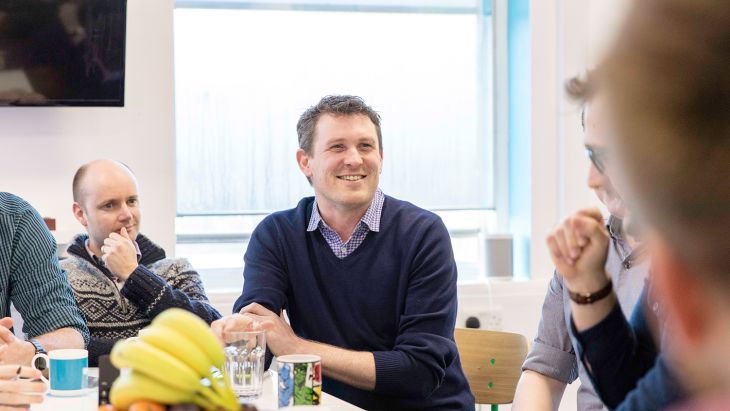How we rebuilt our company strategy

When tough times hit your business, how do you bounce back?
For any company, big or small, having 50% of your revenue dependent upon just one customer is highly risky. We should know - we were once in that very position. One client generated 50% of our income and they were also a minor shareholder in the company.
Anyone could have predicted the perfect storm looming ahead but we were blinded by the mirage of growth right in front of our eyes.
They were growing (so it seemed) and we reaped the apparent benefits. Over a three year period, we steadily increased our revenue and team size but neglected profitability and the establishment of a diversified portfolio.
Eventually, we did realise our situation and began to change tack, reducing our reliance on them. Just in time too.
We were sailing slowly away from the storm but it still hit us hard when they suddenly went into administration. One day they were paying bills and working happily beside us, the next day the staff were gone and the company was insolvent.
Cast-off the panic
Suddenly our gentle drift towards a new business model became a frantic thrash in the water. Or at least initially.
Thankfully, we cast off the initial panic and instead used this traumatic event as a catalyst for change. We refined our values, reassessed our goals and decided it was time to prove we could be a company that had both outstanding work culture and financial stability.
Six strategic steps
Within the first quarter following our perfect storm, we downsized our team (the most painful step in this whole journey) and reassessed our strategy.
These six strategic factors proved key in our turnaround.
1. We became more open and transparent
We ensured the team knew where we were financially on a monthly basis and what we were doing to turn things around.
Openness has become more and more important to us. We’ve found that we can make difficult decisions with the team on board if they can see the rationale behind that decision.
We publish to the team monthly P&L figures, quarterly strategy notes, new business opportunities etc. This transparency extends to our clients too.
We talk with our clients… lots! Whether on the phone, email or on a daily basis via Slack, we ensure we’re delivering what they expect.
2. We focused (initially) on our existing clients
We knew that our existing clients loved working with us and would find an opportunity to do more with us. We, therefore, prioritised their work and talked with them about further opportunities within their business.
For any company in crisis, new business can sound like the answer, or at least the scramble of marketing initiatives can feel like you’re at least doing something. However, the returns on new business are often small, far in the future or just distant pots at the end of a never-ending rainbow.
Focus on your existing customers first, find new business second (this is always true).
3. We abandoned outbound
We’ve tried lots of standard marketing process including Adwords and Outbound Marketing (email & calls). None of these has been successful. Mobile app development is expensive and not required by all companies.
Our marketing strategy is simple: to be well-known for being the safest hands in the industry for delivering mobile application development.
Specifically, we achieve this through:
- Blogging - we write and publish lots of material on our website to show that we know what we’re talking about and (crucially) enjoy working on client projects
- Events - we are involved locally in digital events including founding and sponsoring the Brighton Mobile Meetup which happens regularly and has 350 members.
- Publicising our clients' successes - we’re happy when our clients have success, so we talk in our case studies about how well our clients are doing and our role in that.
- Good quality, natural SEO - when people search for mobile app development, we want them to find us and like us.
- A brand that actually reflects us - people say that when they meet us or come to our offices, we are exactly as our website, blogs, events say we are. This is important to us.
4. We subscribed to oversubscribed
We took on board many of the practical measures outlined in the book by Daniel Priestley ‘Oversubscribed’.
These included; becoming more exclusive and only working on projects and with clients we are passionate about. Some practical steps we took:
We kept the size of the team small enough to ensure we have a long pipeline of work.
We became confident in what we don’t do - we know what we’re good at and what we’re not. We’re good at working on long-term projects, with medium-large clients on mobile applications with complicated data. We’re not good at throw away applications, working with startups and on projects we don’t believe in.
We limited the new clients - we have a finite team, finite time and the ability to deeply understand a finite number of projects & clients. We are therefore seeking to only take on four new clients per year. We use this strategy to plan capacity on a quarterly basis, talking with our existing clients about how many sprints they may require, against the requirements of the incoming new client.
5. We aspired to become a small giant
The pressure for small companies to grow for the sake of it often becomes a pressure which can degrade culture within the organisation. The book ‘Small Giants’ by Bo Burlingham helpfully brings this point out.
We’re now committed to building an excellent, resilient and fantastic company to work for, rather than simply growing for the sake of it.
Practically this means many things, including limiting new clients to only one per quarter and ensuring we work with clients in the long-term
We’re not interested in projects that we build, release and then never hear from the client again. We’d rather do something smaller, but work with the client over multiple years to iterate and build. This ensures we have ongoing work, a deep understanding of the client and can bring massive value to the customer and relationship.
6. We rebuilt our process
We fundamentally changed our project process and contracts. We rarely (in the future we won’t at all) take on fixed priced contracts, where we carry all the risk, and now exclusively work in Agile Scrum. This allows the client to control their budget and we then work with them at the start of each sprint to build the backlog for development and, therefore, the specification for the product.
30% smaller but 4 times bigger?
All of the above have led to a massive turnaround in viability and profitability. Brightec is now on course to make 4 times the profit of previous years, with a team that is 30% smaller.
Watch our video to find out more about what we learned from this experience and how it helped us grow as a business.
Looking for something else?
Search over 450 blog posts from our team
Want to hear more?
Subscribe to our monthly digest of blogs to stay in the loop and come with us on our journey to make things better!

